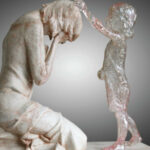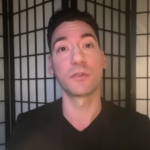Blog Post
How dead babies haunt the dreams of abortionists
NOTE: This is an excerpt from Seeing is Believing: Why Our Culture Must Face the Victims of Abortion by Jonathon Van Maren. It can be purchased here.
I first heard of “fetus dreams” in university It was an essay published in a Norton anthology I had to purchase for one of my first university English courses, published in Harper’s Magazine in October 1990 by a nurse named Sallie Tisdale. It is called “We Do Abortions Here: A Nurse’s Story.” In it, she calls abortion a “sweet brutality,” and attempts to justify what she sees as a necessary evil:
But when I look in the basin, among the curdlike blood clots, I see an elfin thorax, attenuated, its pencilline ribs all in parallel rows with tiny knobs of spine rounding upwards. A translucent arm and hand swim beside. The girl asks to see it, sitting up. “It’s not allowed,” I told her sternly.
I have fetus dreams, we all do here: dreams of abortions one after the other; of buckets of blood splashed on the walls; trees full of crawling fetuses. I dreamed that two men grabbed me and began to drag me away. ‘Let’s do an abortion,’ they said with a sickening leer, and I began to scream, plunged into a vision of sucking, scraping pain, of being spread and torn by impartial instruments that do only what they are bidden.[i]
I’ve had “fetus dreams,” and find it interesting that both an abortion clinic worker and a pro-lifer would instinctively refer to them as the same thing. Other pro-lifers, too, have admitted to me that some nights, after a long, hard day of activism, the realities we work so hard to reveal to the culture will not yet leave them to sleep. I remember one week in particular when I was working with one of my colleagues to produce an abortion video for a campus debate with a late-term abortion provider. Wading through footage of chopped up children slithering out of the birth canal in a bizarre crescendo of blood quickly became the stuff of nightmares.
And abortionists feel the same way. A Mother Jones interview with notorious abortionist William Raushbaum revealed his struggles:
He was troubled by a recurring dream of a fetus trying to hold onto the walls of a uterus by its tiny fingernails. Raised to believe that abortion was wrong, he reasons, “What kind of dreams do you think you are going to have?”[ii]
It was not, one suspects, the moral compass of his youth that troubled his dreams. After all, the nightmare Raushbaum lived and created was horrifying to say the least:
The procedure is gruesome, as anyone who has seen it, including Rashbaum, will attest. One of his former interns remembers watching Rashbaum do a D&E on well-developed twins one hot summer day. He intently leaned in closely and methodically pulled piece after piece of the fetuses out of the mother’s uterus, ignoring the attending staff’s whispers of horror — “It’s twins. It’s twins” — to each other. The intern reacted violently, running home, throwing up, and asking herself, “Is this right?”[iii]
It’s not just Tisdale and Rashbaum, either. One article in a medical journal noted that abortion victims tended to linger in the minds of those who had killed them long after their corpses had been tossed out:
Ambivalent periods were characterized by a variety of otherwise uncharacteristic feelings and behavior including withdrawal from colleagues, resistance to going to work, lack of energy…and an overall sense of uneasiness. Nightmares, images that could not be shaken and preoccupation were also commonly reported. Also common was the deep and lonely privacy within which practitioners had grappled with their ambivalence.[iv]
Another book on late-term abortions noted that while many abortionists felt “technically competent,” the brutal nature of their work still resulted in “strong emotional reactions during or following the procedures, and occasional disquieting dreams.”[v] Abortionists quite literally have to destroy their own instincts and silence their consciences in order to perform the procedures—the Journal of Medical Ethics explained that, “It is clear that physically dismembering and removing the fetus is emotionally distressing for the doctor. A doctor, therefore, has to overcome an element of revulsion in order to do a late term surgical termination of pregnancy.”[vi]
One abortion worker spoke of recurring nightmares where she “was stuffing a baby into the mouth of [an antique] vase. The baby was looking at her with a pleading expression.”[vii] Other abortionists wondered “if the fetus feels pain. They talk[ed] about the soul and where it goes. And about their dreams, in which aborted fetuses stare at them with ancient eyes and perfectly shaped hands and feet, asking, ‘Why? Why did you do this to me?’”[viii] Abortionists know they are killing babies. As one related miserably, “when I put my hands on somebody to feel how big they are and I get kicked, I am barely able to talk at that moment.”[ix]
Sometimes only nightmares still have the power to trouble hardened consciences. Magda Denes captured that reality powerfully in her book In Necessity and Sorrow: Life and Death in an Abortion Hospital, for which she spent time as an observer in an abortion clinic:
Sensibility is blunted through exposure. After weeks of trailing Holzman from OR 1 to OR 2, my sense of meaning dulls. I begin to see “cases,” “cervical apertures,” “fetal tissue” …I worry about snags in tempo during operations, but no differently from the way I worry about an unfamiliar noise in the motor of my car. One time the circulating nurse loses her wedding ring during surgery. She discovers the loss at the end of the operation as the orderly is about to fold the bloody sheets on the floor. She takes the filled plastic bag from the wastebasket and empties it into the middle of the sheets. Both kneel and with their bare hands rummage frantically in the pile of placental tissue and blood and chopped up fetal body parts. “It has to be here,” she says nearly in tears. “We’ll find it,” he reassures her. I am all for them. [It] is frightful to lose one’s wedding ring…Hours later, when the scene reasserts itself in my mind, I do not recognize myself. Is inhumanity a habit? Is indifference the result of the attrition of meaning? If so, one must watch the self like an enemy.[x]
Some of those in the abortion industry have actually cited these traumatic dreams of conscience as the reason they abandoned their bloody practices. Reading their accounts always recalls a snippet of a poem by the ancient writer Aeschylus:
Even in our sleep, pain which cannot forget
Falls drop by drop upon the heart
Until, in our own despair,
Comes wisdom
Through the awful grace of God.
Dr. Bernard Nathanson, the New York abortionist who ran the world’s largest free-standing abortion clinic for several years before becoming pro-life, wrote several books describing the atmosphere inside the abortion industry. One anecdote in his book Aborting America is particularly telling:
I also recall being cornered by the wife of one [abortionist] at the cocktail party we have when the Sixty-Second Street Clinic opened. She drew me aside and talked in a decidedly agitated manner of the increasingly frequent nightmare her husband had been having. He had confessed to her that the dreams were filled with blood and children, and that he had latterly become obsessed with the notion that some terrible injustice would soon be inflicted upon his own children in payment for what he was doing. Another time, the wife of a second doctor, who had done at least 2,000 abortions at the place, phoned to report that her husband had developed a serious drinking problem over the past year that, in her view, was precipitated by the clinic work.[xi]
Throughout the literature by and for abortion workers, there are certain themes. Most abortion workers are initially plagued with guilt for what they are doing. Those who manage to silence their consciences often become cold and morbid—the conversations recorded by David Daleiden and the Center for Medical Progress are evidence of that. Many abortion workers are privately convinced that they are doing something terrible, but for reasons ranging from financial incentive to a belief that abortion is a “necessary evil,” they stay in the business. Many resort to substance abuse to cope—as former abortion worker Nina Whitten related: “I took drugs to wake up in the morning. I took speed while I was at work. And I smoked marijuana, drank lots of alcohol…This is the way I coped with what I did. It was horrible to work there, and there was no good in it.”[xii]
Our collective cultural nightmare impacts all of us—those who kill the babies, those who handle the corpses, and those who try to bring the truth to a public largely unaware of the horror we fund with our taxpayer’s dollars. As thousands of pre-born children die in clinics across the country, many of them live on only in our dreams.
[i] Jason Deparle, “Beyond the Legal Right; Why Liberals and Feminists Don’t like to Talk about the Morality of Abortion,” Washington Monthly, April 1989
[ii] Rebecca Paley, “End of the Road,” Mother Jones, October 2003, accessed August 11, 2017, http://www.motherjones.com/politics/2003/09/end-road/
[iii] Rebecca Paley, “End of the Road,” Mother Jones, October 2003, accessed August 11, 2017, http://www.motherjones.com/politics/2003/09/end-road/
[iv] Kathleen M Roe, “Private Troubles and Public Issues: Providing Abortion and Is Competing Definitions,” Social Science and Medicine 29, (1989): 1197
[v] Second Trimester Abortion: Perspectives After a Decade of Experience (Berger, Brenner, Keith, eds, Martinus Nijhoff Publishers, 1981), in the chapter “Psychological Impact on Patients and Staff,” p. 246.
[vi] Nicholas Johnson, Journal of Medical Ethics 1989, vol. 15, p 82
[vii] Kibel, H. D., “Editorial: Staff Reactions to Abortion,” Obstetrics and Gynecology (1972) 39(1).
[viii] “Why Doctors are Fleeing the Carnage,” Canadian Business and Current Affairs Western Report, November 21, 1994
[ix] Diane M. Gianelli, “Abortion Providers Share Inner Conflicts,” American Medical News, July 12, 1993
[x] Magda Denes, PhD., In Necessity and Sorrow: Life and Death in an Abortion Hospital, (New York: Basic Books Inc. 1976) 239 -240
[xi] Bernard N. Nathanson MD, Aborting America, (New York: Doubleday Company, 1979), 141
[xii] Mary Meehan, “The Ex-Abortionists: Why They Quit,” Human Life Review 26:2–3 (Spring-Summer 2000), 19.









Oh, the heinous brutal inhumanity of it all. When will this genocide ever stop? Dear God, Forgive them for they do not realize what they are doing. Your image bearers.
I can’t understand how we call this civilized. the horror of it all! it disgusts me.
pure evil! I don’t what justification is made.
What could possibly be @sweet” about any if this? Just brutal, horribly brutal.
I started to read this and could not read any further. It is all too horrible:
One is continually reading about how we must think of the children and protect them. What has happened is that our law makers are promoting the killing of these unborn children. Where is their compassion and common sense. So many babies could be put up for adoption as these children ARE wanted.